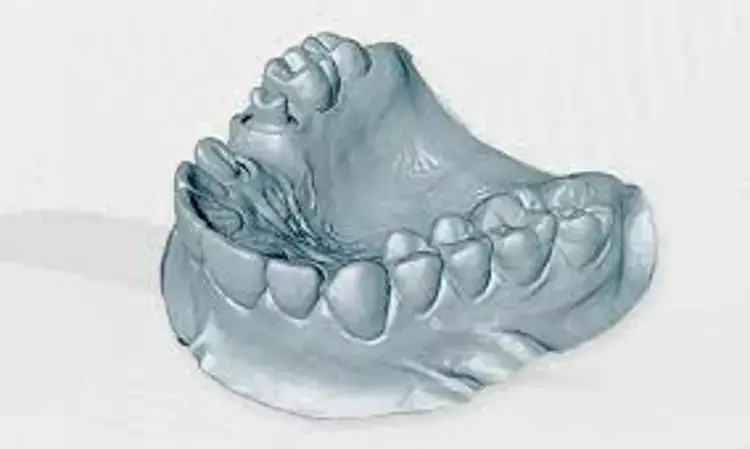- Home
- Medical news & Guidelines
- Anesthesiology
- Cardiology and CTVS
- Critical Care
- Dentistry
- Dermatology
- Diabetes and Endocrinology
- ENT
- Gastroenterology
- Medicine
- Nephrology
- Neurology
- Obstretics-Gynaecology
- Oncology
- Ophthalmology
- Orthopaedics
- Pediatrics-Neonatology
- Psychiatry
- Pulmonology
- Radiology
- Surgery
- Urology
- Laboratory Medicine
- Diet
- Nursing
- Paramedical
- Physiotherapy
- Health news
- Fact Check
- Bone Health Fact Check
- Brain Health Fact Check
- Cancer Related Fact Check
- Child Care Fact Check
- Dental and oral health fact check
- Diabetes and metabolic health fact check
- Diet and Nutrition Fact Check
- Eye and ENT Care Fact Check
- Fitness fact check
- Gut health fact check
- Heart health fact check
- Kidney health fact check
- Medical education fact check
- Men's health fact check
- Respiratory fact check
- Skin and hair care fact check
- Vaccine and Immunization fact check
- Women's health fact check
- AYUSH
- State News
- Andaman and Nicobar Islands
- Andhra Pradesh
- Arunachal Pradesh
- Assam
- Bihar
- Chandigarh
- Chattisgarh
- Dadra and Nagar Haveli
- Daman and Diu
- Delhi
- Goa
- Gujarat
- Haryana
- Himachal Pradesh
- Jammu & Kashmir
- Jharkhand
- Karnataka
- Kerala
- Ladakh
- Lakshadweep
- Madhya Pradesh
- Maharashtra
- Manipur
- Meghalaya
- Mizoram
- Nagaland
- Odisha
- Puducherry
- Punjab
- Rajasthan
- Sikkim
- Tamil Nadu
- Telangana
- Tripura
- Uttar Pradesh
- Uttrakhand
- West Bengal
- Medical Education
- Industry
Cast or impression digitization more accurate than intraoral scanning for complete denture fabrication

Cast or impression digitization more accurate than intraoral scanning for complete denture fabrication suggests a new study published in the Journal Of Prosthodontics
To assess, clinically, patient satisfaction of additively manufactured complete dentures with intraoral scanning and hybrid cast digitization in comparison with conventional complete dentures.
Participants who were edentulous in both arches were recruited and received three types of complete dentures (CDs): conventionally manufactured with conventional impression (CC), additively manufactured with intraoral scanning (AMI), and additively manufactured with cast digitization (AMH). Definitive impressions of the edentulous arches were made with medium viscosity polyvinyl siloxane (Hydrorise Monophase; Zhermack, Italy) for the CC group, intraoral scanning (TRIOS 4; 3Shape, Copenhagen, Denmark) for the AMI group, and laboratory scanning of the definitive casts (Ceramill Map400 AMANNGIRRBACH, Pforzheim, Deutschland) for the AMH group. The trial dentures of the CC group were scanned for occlusion registrations of the AMI and AMH groups and were used to guide the designing process (Exocad 3.0 Galway; Exocad GmbH). The AMI and AMH dentures were additively manufactured with a vat-polymerization 3D printer (Sonic XL 4K; phrozen, Taiwan). Patient satisfaction and clinical outcome were assessed with OHIP EDENT, and 14-factor criteria, respectively. Statistical analyses were performed with paired sample t-test and one-way repeated measure ANOVA for satisfaction, Wilcoxon signed rank test for clinical outcome, and Pearson's r (r) for effect size, with α = 0.05.
Results
A total of 20 participants were included. Satisfaction had no statistically significant difference within or among the groups (p < 0.105). Within-group comparison between the two arches showed no statistical significance for the clinical outcome except for a significantly higher maxillary AMI score (p = 0.01, r = −0.40 with medium effect size). For among group's comparison; AMI had a significantly lower score than CC for the maxillary and mandibular arches (p = 0.01, r = −0.40, medium effect size, and p = 0.003, r = −0.47, medium effect size), and significantly lower score than the mandibular AMH (p = 0.03, r = −0.47, medium effect size), with significantly lower quality in teeth arrangement and retention domains for the AMI, and teeth arrangement for the AMH, in comparison with CC.
Conclusions
Patient satisfaction with both types of additively manufactured dentures is comparable to conventional dentures. The comparable overall clinical outcomes between hybrid and conventional dentures indicate that additive manufacturing is an acceptable clinical substitute for the conventional methods. However, additively manufactured dentures made with intraoral scanning have lower clinical quality and retention than hybrid and conventional dentures, particularly for the mandibular arch. Teeth arrangement of both additively manufactured dentures is clinically inferior to the conventional denture.
Reference:
Al-Kaff, FT, Al Hamad, KQ. Additively manufactured CAD-CAM complete dentures with intraoral scanning and cast digitization: A controlled clinical trial. J Prosthodont. 2023; 1– 7. https://doi.org/10.1111/jopr.13704
Keywords:
Cast, impression, digitization, more, accurate, intraoral, scanning, complete, denture, fabrication, Al-Kaff, FT, Al Hamad, KQ, Journal Of Prosthodontics
Dr. Shravani Dali has completed her BDS from Pravara institute of medical sciences, loni. Following which she extensively worked in the healthcare sector for 2+ years. She has been actively involved in writing blogs in field of health and wellness. Currently she is pursuing her Masters of public health-health administration from Tata institute of social sciences. She can be contacted at editorial@medicaldialogues.in.
Dr Kamal Kant Kohli-MBBS, DTCD- a chest specialist with more than 30 years of practice and a flair for writing clinical articles, Dr Kamal Kant Kohli joined Medical Dialogues as a Chief Editor of Medical News. Besides writing articles, as an editor, he proofreads and verifies all the medical content published on Medical Dialogues including those coming from journals, studies,medical conferences,guidelines etc. Email: drkohli@medicaldialogues.in. Contact no. 011-43720751


